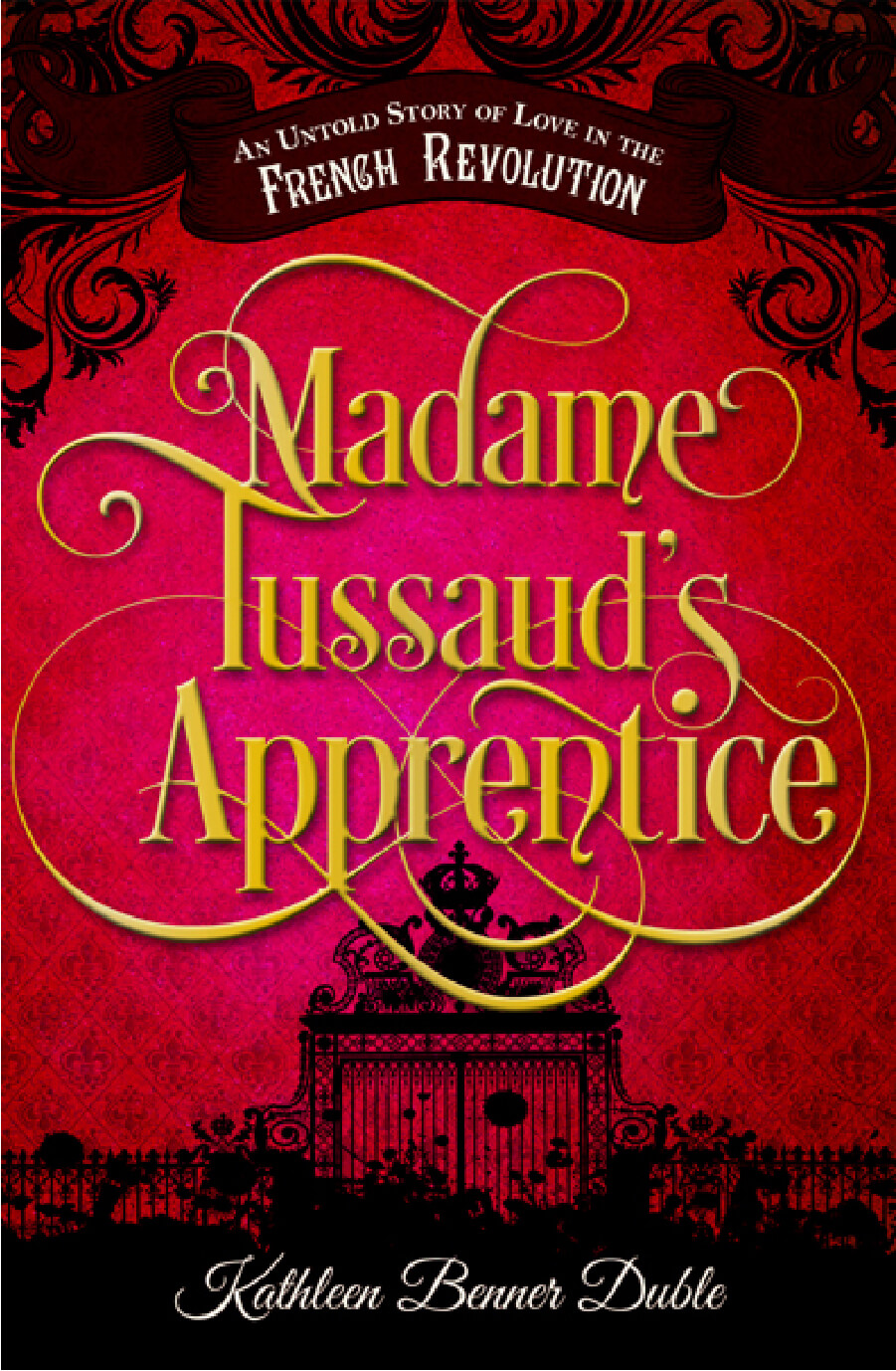

Madame Tussaud’s Apprentice
Publisher: Merit Press, Fall 2014 - Alma Press, UK, 2015
Age group: 12-17
Jacket illustration: Frank Rivera
Genre: Historical Fiction
ISBN 13: 9781440581168
To buy this book
- Description
- Book Club Ideas
- Discussions
Description
Celie Rosseau has lost everything: Her father was shot by the Comte d’Artois’s men for accidentally wandering onto his private lands, and her mother and brother have died from starvation since they were unable to work the fields after the death of her father. In the aftermath of so much loss, Celie decides to go to Paris to join the freedom fighters there, men and women who are rebelling against the king and the aristocracy, asking for their fair share of the wealth.
But the trip nearly kills her. Alone and starving by the side of the road to Paris, a boy, Algernon, comes along and rescues her from death. Soon Celie is pulled into Algernon’s world of thievery, where she discovers she has quite the talent. Her fingers are nimble in picking locks, and her mind is a steel trap when it comes to remembering and redrawing the inside of houses to rob. And too, she finds herself falling for the handsome Algernon.
But when the famous waxwork lady, Madame Tussaud, catches the two, they are forced to work for the waxwork house or face the gallows.
Soon, Celie finds herself caught up in the art of making wax figures. Madame Tussaud is thrilled with Celie’s drawing skills, eventually taking Celie to Versailles to help teach the King’s sister. It is at the palace that Celie begins to see a new side to the wealthy – a kinder side, a human side.
So when at last the revolution comes, and Algernon becomes embroiled in the arrests and deposing of the king, Celie is left to choose sides. While she supports the right of the people to rebel, can she stomach the violence and the beheadings that seem to accompany the fight for equality?
What will she do? Stay with Madame Tussaud and her life of privilege making art and enjoying her freedom? Or run away with Algernon, the boy she loves, and join the path of revolution and revenge?
Read my book MADAME TUSSAUD’S APPRENTICE to find out.
And start your own reading revolution!!!
Named 9 YOUNG ADULT HISTORICAL NOVELS THAT BRING THE PAST TO LIFE
CHECK IT OUT HERE
The historical Madame Tussaud provides an unusual lens on the French Revolution.
Sixteen-year-old thief Celie and her companion in crime, Algernon, make a precarious living stealing from the French elite. Both teens resent the aristocracy, believing that the rich caused the deaths of their families. By chance, Celie’s artistic talents come into play when she is arrested for stealing from Madame Tussaud; the famed waxwork lady, whose art is already one of the popular attractions in Paris, takes her in to make use of her skill at drawing uncannily realistic representations. Madame Tussaud is also the drawing tutor to the king’s sister, Madame Elizabeth, which brings the reluctant Celie into the last innocent days at Versailles. When the revolution begins, Algernon fights for freedom, but Madame Tussaud faces the guillotine. Duble’s writing flows smoothly. . . The history behind the story (such as the fact that Madame Tussaud was forced to make wax casts of the severed heads of the royals, including her friend Madame Elizabeth) is fascinating, and it propels the story to its somewhat hopeful end. . .
. . An intriguing look at an ever compelling time. KIRKUS (Historical fiction. 12-16)
Doing research on the French Revolution? Check out this site
Book Club ideas
VENUE: Of course, Paris would be the perfect spot to hold your book club meeting for MADAME TUSSAUD. Or even Versailles, if you really want a glamorous venue! But because most of us lack our own private jet or millions of dollars with which to fly to Paris on a quick book-clubbing jaunt, why not bring Paris to your book clubbers instead? Buy some French music. Set up some small tables with candlelight. Find some cheap berets for your book clubbers to wear. Spray a light scent of perfume into the air. Now close your eyes. Are you in Paris yet?
FOOD: If not, the food should send you there. How much fun is it to dish out food when the subject of your book takes place in France? With the explosion of cheese shops around the country, find a nice warm baguette and experiment with different kinds of French cheeses – a cow’s milk, a goat cheese and a bit of pate, and France is within your grasp.
If you want to go really wild, cook up some roast chicken and haricots vert – the same food Celie dreams about in the Palais-Royal. Or get your book clubbers to try escargot (snails) a real French delicacy.
Here’s a great roast chicken recipe you can try from one of my very best friends:
SARAH SMITH CHICKEN
1 stick butter – room temperature
¼ cup plus more soy sauce
1 whole roasting chicken
minced garlic
Chinese Five Spice
Remove giblets from cavity in roasting chicken. Toss giblets.
Mix stick of butter with 3-4 large spoonfuls of garlic
Stuff garlic butter under the breast skin of the roasting chicken
Divide and pour ¼ cup soy sauce into both sides of breast under skin
Pour more soy sauce over the top of the chicken
Sprinkle Chinese five spice over soy sauce on chicken
Bake at 450 for 20 minutes
Reduce heat to 350 and bake for 1½ hours more
Carve and serve
If, on the other hand, you are meeting for breakfast, like Marie Antoinette, why not serve your book clubbers warm, buttery croissants with hot chocolate made with whole milk and real chocolate? Have them imagine how they would describe the new hot drink that was the rage across Europe if this was the first time they were trying it!
ONLINE RESOURCE:
www.history.com/topics/french-revolution or www.youtube.com/watch to watch One Direction’s Zayn Malik being sculpted at Madame Tussaud’s
SPECIAL GUEST: If you live in a city where Madame Tussaud has one of her museums, consider making a trip and seeing her wax figures in person. Try and get a tour with one of the museum curators. If however, there is not a museum near you, why not contact the museum itself and try to get a Skype visit with one of the staff members. Seeing the actual process involved in making a wax figure will bring the book to life, too!
Discussions
SOCIAL STUDIES:
- Discuss the ways in which these various types of government function and how they can be successful or detrimental to the needs of the people: monarchy, democracy, communism, oligarchy, fascism, totalitarianism, and dictatorship.
- Examine other countries where a power vacuum has been created due to the fall of a leader. Some examples might be: The murder of Tsar Nicholas and his family in Russia; the capture of Saddam Hussein in Iraq; the fall of Emperor Pu Yi in China; the assassination of John F Kennedy in Texas; the death of Tito in Yugoslavia. How did stabilization occur or not occur in these countries? What lesson can be obtained from these transitions of power?
HISTORY
- The French Revolution fell right on the heels of the American Revolution. Discuss ways in which the Americans might have inspired the French to believe in self-government. How were the revolutions similar? How were they different?
- King Louis XVI and his family were brought to Paris in the summer of 1793 but their executions didn’t take place until the summer of 1794. Why do you think the French Revolution and the deposing of a king took such an enormous amount of time to play out?
- What other factors, in addition to the people’s unrest, led to the French Revolution?
MATH
- The National Assembly changed the calendar and the process of telling time in 1793. Research how this new calendar and way of telling time worked and why eventually both were suspended.
- Consider and discuss how economics have affected other revolutions: Russian, Chinese, Cuban, Iranian, American. What is the lesson to be gained from considering the state of the economy prior to these past events?
SCIENCE
- The guillotine was considered a more humane method of execution than beheading by the sword. Discuss the science of execution then and now? How have we advanced in this process or do you feel no progress has been made?
- Discuss how the drought of 1788 might have affected the flames of revolution and what other world uprisings were due in part to weather related conditions.
ARTS
- Why do you think a wax works house was so popular in 1792? Compare their popularity and relevance to society then and now? What forms of art most express society’s needs these days and why is that?
- How has the process of making wax figures changed since 1792?


